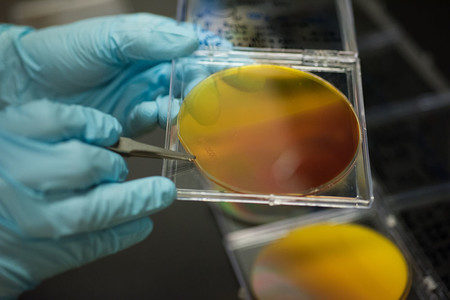Mar
7
New Materials Found In a New Way to Split Water
March 7, 2017 | Leave a Comment
Researchers at Caltech and the Berkeley Lab have in just two years nearly doubled the number of materials known to have potential for use in solar fuels. Using a new high-throughput method of identifying new materials, a team of researchers led by Caltech’s John Gregoire and Berkeley Lab’s Jeffrey Neaton and Qimin Yan have found 12 promising new photoanodes.

Scientists at JCAP create new materials by spraying combinations of elements onto thin plates. Image Credit: Caltech. Click image foe the largest view.
The paper about the method and the new photoanodes has been published in the online edition of the Proceedings of the National Academy of Sciences. The new method was developed through a partnership between the Joint Center for Artificial Photosynthesis (JCAP) at Caltech, and Berkeley Lab’s Materials Project, using resources at the Molecular Foundry and the National Energy Research Scientific Computing Center (NERSC).
Solar fuels, a dream of clean-energy research, are created using only sunlight, water, and carbon dioxide (CO2). Researchers are exploring a range of target fuels, from hydrogen gas to liquid hydrocarbons, but producing any of these fuels involves splitting water.
Each water molecule is comprised of an oxygen atom and two hydrogen atoms. The hydrogen atoms are extracted, and then can be reunited to create highly flammable hydrogen gas or combined with CO2 to create hydrocarbon fuels, creating a plentiful and renewable energy source. The problem, however, is that water molecules do not simply break down when sunlight shines on them – if they did, the oceans would not cover most of the planet. They need a little help from a solar-powered catalyst.
To create practical solar fuels, scientists have been trying to develop low-cost and efficient materials, known as photoanodes, that are capable of splitting water using visible light as an energy source. Over the past four decades, researchers identified only 16 of these photoanode materials. Now, using a new high-throughput method of identifying new materials, the Caltech and Berkeley Lab team have found 12 promising new photoanodes.
Gregoire, JCAP thrust coordinator for Photoelectrocatalysis and leader of the High Throughput Experimentation group said, “This integration of theory and experiment is a blueprint for conducting research in an increasingly interdisciplinary world. It’s exciting to find 12 new potential photoanodes for making solar fuels, but even more so to have a new materials discovery pipeline going forward.”
Neaton, the director of the Berkeley Lab Molecular Foundry said, “What is particularly significant about this study, which combines experiment and theory, is that in addition to identifying several new compounds for solar fuel applications, we were also able to learn something new about the underlying electronic structure of the materials themselves.”
Previous materials discovery processes relied on cumbersome testing of individual compounds to assess their potential for use in specific applications. In the new process, Gregoire and his colleagues combined computational and experimental approaches by first mining a materials database for potentially useful compounds, screening it based on the properties of the materials, and then rapidly testing the most promising candidates using high-throughput experimentation.
In the work described in the PNAS paper, they explored 174 metal vanadates – compounds containing the elements vanadium and oxygen along with one other element from the periodic table.
The research, Gregoire says, reveals how different choices for this third element can produce materials with different properties, and reveals how to “tune” those properties to make a better photoanode.
Gregoire sumed up for the press release saying, “The key advance made by the team was to combine the best capabilities enabled by theory and supercomputers with novel high throughput experiments to generate scientific knowledge at an unprecedented rate.”
Choosing which of the news items, the new water splitting materials or the process used to find them, is the most exciting, is a tough choice as both have immense future potential. For now the process looks the most interesting as it might be used for refine the results already found.
This gets us to 28 photoanodes (or specialized catalysts) from which to build out. In any case, these 28 materials have properties that must enchant researchers looking into other material combinations. One of these days there is going to be a compound found that will make solar water splitting marketable and scaleable. That day is closer now than ever before.

